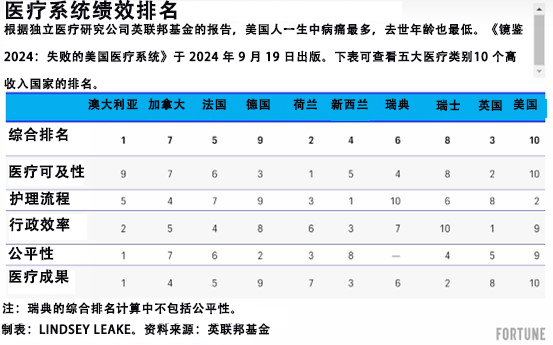
针对10个高收入国家医疗系统绩效的一项新分析显示,美国的医疗系统最特别,可惜是特别糟糕。
根据独立医疗研究公司英联邦基金(Commonwealth Fund)的报告,美国人一生中病痛最多,去世年龄也最低。《镜鉴2024:失败的美国医疗系统》(Mirror 2024: A Portrait of the Failing U.S. Health System)已于9月19日出版。
除了总体排名最差之外,五大类别中有三个类别美国(公平性、医疗成果和医疗可及性)排名最后。行政效率方面美国表现稍好,排名第九,领先瑞士。但医疗支出超过了参与评估的其他国家。
“在保护人民健康和福利方面,美国没尽到作为国家的主要义务,”英联邦基金主席约瑟夫·贝坦科尔特在一份准备好的声明中表示,“医疗资金支出最多,效果却最差,如此现状不可持续。关键不在于缺乏资源,而是资源利用的方式。”
美国只在护理流程类别中表现出色,主要涉及安全、预防、协调和患者参与等。报告称,美国之所以能排第二,“主要因为成功提供预防服务,如乳房X光检查和流感疫苗接种,对患者安全也足够重视。”
《镜鉴》报告使用的数据为2021年到2023年收集,70个指标涵盖五个类别。英联邦基金国际卫生政策调查的受访者包括基层医生,年龄大于18岁的普通人群以及65岁及以上人群。其他数据来源包括世界卫生组织(World Health Organization)和经济合作与发展组织(Organization for Economic Cooperation and Development)。
以下是各国2024年与2021年上一份报告相比情况。三年前排名第一的挪威退出了国际卫生政策调查,因此未参与今年排名。
医疗系统最佳的高收入国家
1.澳大利亚(上次排名第3位)
2.荷兰(同上次)
3.英国(上次排名第4位)
4.新西兰(上次排名第6位)
5.法国(上次排名第8位)
医疗系统最差的高收入国家
6.瑞典(上次排名第7位)
7.加拿大(上次排名第10位)
8.瑞士(上次排名第9位)
9.德国(上次排名第5位)
10.美国(上次排名第11位,虽进步一位但仍排最末)
报告指出,多数国家之间整体表现差异相对较小,但美国是唯一表现“明显较差”的国家。
医疗领域其他排名
·医疗可及性最佳:荷兰(同上次)
·医疗可及性最差:美国(同上次)
·行政效率最高:英国(上次为挪威)
·行政效率最差:瑞士(上次为美国)
·护理流程最佳:新西兰(同上次)
·护理流程最差:瑞典(同上次)
·公平性最佳:澳大利亚(同上次)
·公平性最差:美国(同上次)
·医疗成果最佳:澳大利亚(同上次)
·医疗成果最差:美国(同上次)
“《镜鉴》报告强调国际比较的重要性,可为改善美国卫生系统提供证据和启发,”英联邦基金负责国际卫生政策和实践创新的副总裁雷金纳德·威廉姆斯在一份准备好的声明中表示,“其他国家已成功满足国民的健康需求,美国的卫生系统却仍然严重落后。”
“报告显示,采取有效的战略以及明智的投资可以加强美国医疗系统,从而更好地满足国民需求。如果能切实做到,美国的地位就能提升。”

美国医疗支出有多少?
美国医疗支出相对较高并不是什么新鲜事,然而美国与其他九个国家医疗支出的差距已形成巨大鸿沟。
从1980年开始,美国医疗支出占国内生产总值(GDP)的8.2%;英国支出最低,为5.1%。到2020年,美国支出已攀升至18.6%。2022年比例降至16.5%,其他九个国家的医疗支出则介于9.8%(澳大利亚)和12.6%(德国)。
报告凸显了具有讽刺意味的事实,即美国在医疗领域支出最多却表现最差。此外,医疗最好的两个国家,澳大利亚和荷兰反而支出最少。
美国医疗改革并非毫无希望
今年是大选之年,医疗改革是美国两党选民最关心的问题,《镜鉴》报告也尖锐反映了美国的问题。
美国医疗保险覆盖相当割裂,2600万美国人没有保险,其他九个国家都实现了全民覆盖。对很多美国人来说,处理医疗账单就是噩梦,英国和澳大利亚则将账单负担降至最低。在各年龄段中,美国可预防和可治疗的死亡率均为最高。预计美国人寿命将比10个国家平均水平少4年以上,原因很大程度上是枪支暴力和药物滥用。
原因还有很多。尽管如此,联邦基金的研究人员认为,研究结果并非不可逾越的障碍,而是值得学习的时刻。在关于该报告的新闻稿中,研究人员建议采取一些政策举措,包括:
·将医疗保健覆盖范围扩大到未参保人群,改革保险覆盖范围以达到最起码的适当标准,包括限制患者的自付费用,让医疗更实惠也更方便。
·消除低收入个人、非裔、拉丁裔和原住民、女性和农村居民在健康和医疗服务方面的差距,改善健康公平。相关弱势人群经常面临歧视,享受的医疗质量较低。
“由于医疗系统失败,太多美国人寿命短且病痛多,”贝坦科尔特说,“我们要建立价格低廉,人人都能受益的医疗系统。现在就是迎接这一挑战的时候。”(财富中文网)
译者:梁宇
审校:夏林
针对10个高收入国家医疗系统绩效的一项新分析显示,美国的医疗系统最特别,可惜是特别糟糕。
根据独立医疗研究公司英联邦基金(Commonwealth Fund)的报告,美国人一生中病痛最多,去世年龄也最低。《镜鉴2024:失败的美国医疗系统》(Mirror 2024: A Portrait of the Failing U.S. Health System)已于9月19日出版。
除了总体排名最差之外,五大类别中有三个类别美国(公平性、医疗成果和医疗可及性)排名最后。行政效率方面美国表现稍好,排名第九,领先瑞士。但医疗支出超过了参与评估的其他国家。
“在保护人民健康和福利方面,美国没尽到作为国家的主要义务,”英联邦基金主席约瑟夫·贝坦科尔特在一份准备好的声明中表示,“医疗资金支出最多,效果却最差,如此现状不可持续。关键不在于缺乏资源,而是资源利用的方式。”
美国只在护理流程类别中表现出色,主要涉及安全、预防、协调和患者参与等。报告称,美国之所以能排第二,“主要因为成功提供预防服务,如乳房X光检查和流感疫苗接种,对患者安全也足够重视。”
《镜鉴》报告使用的数据为2021年到2023年收集,70个指标涵盖五个类别。英联邦基金国际卫生政策调查的受访者包括基层医生,年龄大于18岁的普通人群以及65岁及以上人群。其他数据来源包括世界卫生组织(World Health Organization)和经济合作与发展组织(Organization for Economic Cooperation and Development)。
以下是各国2024年与2021年上一份报告相比情况。三年前排名第一的挪威退出了国际卫生政策调查,因此未参与今年排名。
医疗系统最佳的高收入国家
1.澳大利亚(上次排名第3位)
2.荷兰(同上次)
3.英国(上次排名第4位)
4.新西兰(上次排名第6位)
5.法国(上次排名第8位)
医疗系统最差的高收入国家
6.瑞典(上次排名第7位)
7.加拿大(上次排名第10位)
8.瑞士(上次排名第9位)
9.德国(上次排名第5位)
10.美国(上次排名第11位,虽进步一位但仍排最末)
报告指出,多数国家之间整体表现差异相对较小,但美国是唯一表现“明显较差”的国家。
医疗领域其他排名
·医疗可及性最佳:荷兰(同上次)
·医疗可及性最差:美国(同上次)
·行政效率最高:英国(上次为挪威)
·行政效率最差:瑞士(上次为美国)
·护理流程最佳:新西兰(同上次)
·护理流程最差:瑞典(同上次)
·公平性最佳:澳大利亚(同上次)
·公平性最差:美国(同上次)
·医疗成果最佳:澳大利亚(同上次)
·医疗成果最差:美国(同上次)
“《镜鉴》报告强调国际比较的重要性,可为改善美国卫生系统提供证据和启发,”英联邦基金负责国际卫生政策和实践创新的副总裁雷金纳德·威廉姆斯在一份准备好的声明中表示,“其他国家已成功满足国民的健康需求,美国的卫生系统却仍然严重落后。”
“报告显示,采取有效的战略以及明智的投资可以加强美国医疗系统,从而更好地满足国民需求。如果能切实做到,美国的地位就能提升。”
医疗系统绩效排名
根据独立医疗研究公司英联邦基金的报告,美国人一生中病痛最多,去世年龄也最低。《镜鉴2024:失败的美国医疗系统》于 2024 年 9 月 19 日出版。下表可查看五大医疗类别10 个高收入国家的排名。
澳大利亚 加拿大 法国 德国 荷兰 新西兰 瑞典 瑞士 英国 美国
综合排名
医疗可及性
护理流程
行政效率
公平性
医疗成果
注:瑞典的综合排名计算中不包括公平性。
制表:Lindsey Leake。资料来源:英联邦基金
美国医疗支出有多少?
美国医疗支出相对较高并不是什么新鲜事,然而美国与其他九个国家医疗支出的差距已形成巨大鸿沟。
从1980年开始,美国医疗支出占国内生产总值(GDP)的8.2%;英国支出最低,为5.1%。到2020年,美国支出已攀升至18.6%。2022年比例降至16.5%,其他九个国家的医疗支出则介于9.8%(澳大利亚)和12.6%(德国)。
报告凸显了具有讽刺意味的事实,即美国在医疗领域支出最多却表现最差。此外,医疗最好的两个国家,澳大利亚和荷兰反而支出最少。
美国医疗改革并非毫无希望
今年是大选之年,医疗改革是美国两党选民最关心的问题,《镜鉴》报告也尖锐反映了美国的问题。
美国医疗保险覆盖相当割裂,2600万美国人没有保险,其他九个国家都实现了全民覆盖。对很多美国人来说,处理医疗账单就是噩梦,英国和澳大利亚则将账单负担降至最低。在各年龄段中,美国可预防和可治疗的死亡率均为最高。预计美国人寿命将比10个国家平均水平少4年以上,原因很大程度上是枪支暴力和药物滥用。
原因还有很多。尽管如此,联邦基金的研究人员认为,研究结果并非不可逾越的障碍,而是值得学习的时刻。在关于该报告的新闻稿中,研究人员建议采取一些政策举措,包括:
·将医疗保健覆盖范围扩大到未参保人群,改革保险覆盖范围以达到最起码的适当标准,包括限制患者的自付费用,让医疗更实惠也更方便。
·消除低收入个人、非裔、拉丁裔和原住民、女性和农村居民在健康和医疗服务方面的差距,改善健康公平。相关弱势人群经常面临歧视,享受的医疗质量较低。
“由于医疗系统失败,太多美国人寿命短且病痛多,”贝坦科尔特说,“我们要建立价格低廉,人人都能受益的医疗系统。现在就是迎接这一挑战的时候。”(财富中文网)
译者:梁宇
审校:夏林
The U.S. health care system is in a class all its own, according to a new analysis of health system performance in 10 high-income countries—but in a devastating way.
Americans live the sickest lives and die the youngest, per a report by the Commonwealth Fund, an independent health care research firm. Mirror, Mirror 2024: A Portrait of the Failing U.S. Health System was published Thursday.
The U.S. came in last in three of five categories—equity, health outcomes, and access to care—in addition to having the poorest overall ranking. The country performed slightly better in administrative efficiency, finishing ninth ahead of Switzerland. This, despite spending more than any other nation included in the assessment.
“The U.S. is failing one of its principal obligations as a nation: to protect the health and welfare of its people,” Dr. Joseph Betancourt, president of the Commonwealth Fund, said in a prepared statement. “The status quo—continually spending the most and getting the least for our health care dollars—is not sustainable. It isn’t about lack of resources—it’s clearly about how they are being spent.”
The U.S. excelled only in a category called care process, which considers safety, prevention, coordination, and patient engagement. Its second-place finish, the report said, “is the result of the successful provision of preventive services, such as mammograms and flu vaccinations, and an emphasis on patient safety.”
Mirror, Mirror used data collected from 2021 through 2023, with 70 metrics spanning the five categories. Commonwealth Fund International Health Policy Survey respondents included primary care physicians, the general population of adults aged 18 and older, and a subset of those 65 and older. Additional data sources included the World Health Organization and the Organization for Economic Cooperation and Development.
Below are each country’s 2024 ranking, compared to the previous 2021 report. Norway, which took the top spot three years ago, exited the International Health Policy Survey and isn’t included in this year’s rankings.
High-income countries with best health care systems
1. Australia (up from No. 3)
2. Netherlands (same)
3. U.K. (up from No. 4)
4. New Zealand (up from No. 6)
5. France (up from No. 8)
High-income countries with worst health care systems
6. Sweden (up from No. 7)
7. Canada (up from No. 10)
8. Switzerland (up from No. 9)
9. Germany (down from No. 5)
10. U.S. (technically up from No. 11 but still last place)
While differences in overall performance between most countries were relatively small, the report noted, the U.S. was the sole outlier with “dramatically lower” performance.
Other health care rankings
·Best access to care: Netherlands (same)
·Worst access to care: U.S. (same)
·Best administrative efficiency: U.K. (was Norway)
·Worst administrative efficiency: Switzerland (was U.S.)
·Best care process: New Zealand (same)
·Worst care process: Sweden (same)
·Best equity: Australia (same)
·Worst equity: U.S. (same)
·Best health outcomes: Australia (same)
·Worst health outcomes: U.S. (same)
“Mirror, Mirror underscores the importance of international comparisons, offering evidence and inspiration to improve America’s health system,” Reginald Williams, Commonwealth Fund vice president of international health policy and practice innovations, said in a prepared statement. “While other nations have successfully met their populations’ health needs, the U.S. health system continues to lag significantly.
“This report shows that by adopting proven strategies and making smart investments, America can enhance its health system to better meet the needs of its people. There’s no reason we can’t elevate our standing if we choose to do so.”
HEALTH CARE SYSTEM PERFORMANCE RANKINGS
Americans live the sickest lives and die the youngest, per a report by the Commonwealth Fund, anindependent health care research firm. Mirror, Mirror 2024: A Portrait of the Failing U.S. Health System waspublished Sept. 19, 2024. Scroll through the table below to see how 10 high-income countries rank in fivehealth care categories.
AUS CAN FRA GER NETH NZ SWE SWIZ U.K U.S.
OVERALL RANKING
ACCESS TO CARE
CARE PROCESS
ADMINISTRATIVE EFFICIENCY
EQUITY
HEALTH OUTCOMES
NOTE: EQUITY NOT INCLUDED IN SWEDEN'S OVERALL RANKING CALCULATION.
TABLE: LINDSEY LEAKE·SOURCE: COMMONWEALTHFUND
How much is the U.S. spending on health care?
The nation’s relatively high health care spending isn’t new, but the gap between U.S. expenditures and those of the nine other ranked countries has widened to a chasm.
Beginning in 1980, U.S. health care spending was 8.2% of its gross domestic product (GDP); the U.K. had the lowest spending at 5.1%. By 2020, U.S. spending had climbed to a high of 18.6%. That dipped to 16.5% in 2022, when spending of the other nine countries was between 9.8% (Australia) and 12.6% (Germany).
The report highlights the irony that the country that spent the most on health care, the U.S., performed the poorest. What’s more, the two countries that performed the best, Australia and the Netherlands, spent the least.
Hope not lost for U.S. health care reform
In this presidential election year, health care reform is top of mind for American voters on both sides of the political aisle, and Mirror, Mirror paints the nation’s problems in striking contrast.
Health insurance coverage in the U.S. is fragmented—leaving 26 million Americans uninsured—while the other nine countries boast universal coverage. Navigating medical bills is a nightmare for many Americans, yet the U.K. and Australia minimize billing burdens. The U.S. has the highest rates of preventable and treatable deaths among all ages. Americans are projected to live more than four fewer years than the 10-country average, in no small part due to gun violence and substance abuse.
The list goes on. Still, Commonwealth Fund researchers concluded their findings presented more a teachable moment than an insurmountable obstacle. In a news release about the report, they recommended a number of policy initiatives, including:
·Make health care more affordable and more accessible by extending health care coverage to the remaining uninsured and reforming insurance coverage to meet minimal standards of adequacy, including limits on patients’ out-of-pocket expenses.
·Improve health equity by eliminating disparities in the health and health care delivery that low-income individuals, Black, Latino, and Indigenous people, women, and people who live in rural areas receive. These populations often face discrimination and receive lower-quality care.
“Too many Americans are living shorter, sicker lives because of this failure,” Betancourt said. “We need to build a health system that is affordable and that works for everyone. It’s past time that we step up to this challenge.”






